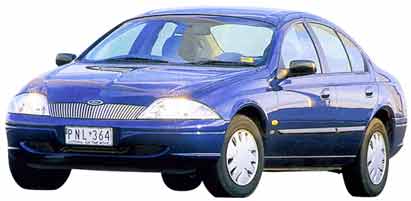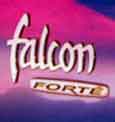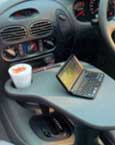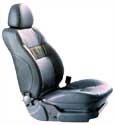Home
» Falcon
» AU Falcon
AU
Falcon was an all new car, and as with previous new models (XA, XD, EA), Ford
Aus first looked overseas for a replacement. Back in 1989, due to bloated costs,
it was intended local manufacturing would be shut down and the future Falcon
would be replaced with an import.
 (1998
- 2000)
(1998
- 2000)But
in 1993, John Ogden persuaded Ford US that axing Falcon and replacing it with
a front drive car would be commercial suicide. This was short-lived, however,
because in 1994, Ford 2000 was unveiled, a radical restructuring of Ford’s
global operations, intended to share around the same product platforms and engines
across all markets. The 1996 Ford Taurus was considered, although research indicated
that 69% of Falcons had towbars fitted. There was a perception that rear-wheel
drive cars towed better - the Taurus was front drive - and the Taurus could
not hold a V8 engine. There would also be no other variants - just a sedan and
wagon. The European Ford Scorpio and Mazda 929 were also considered but they
were too narrow and would put the Falcon into the Camry/Magna class. Ford US
grudgingly agreed to an all-new Falcon, with the proviso that it would control
the key design and development decisions.
Work could now begin on the most controversial part of the AU - its styling.
Chief designer Steve Park’s brief was to make the car appear smaller,
lighter, tighter and nothing like its rival. “We did not want to reheat
the old soup,” Park said. Soon after the early sketches and clay models,
Ford’s stupid “New Edge” international design philosophy began
to emerge. New Edge translates into taut, crisp surfaces with sharp angles,
providing a more athletic stance as opposed to the softer, rounded shapes of
many early-1990s cars. The European Ford Ka
and Focus
are prime examples of this radical styling theme.
Research showed that the typical Falcon buyer was male in his 40s or 50s, so
the marketers wanted the car to appear a little smaller and softer, to interest
female buyers, yet lithe enough to attract younger males.
AU
Falcon Photos (photos
are cropped, click to enlarge)

| Ford
AU Falcon |
| On
Sale: September 1998 - April 2000 |
| How
do I know it's an AU? Edge design with sharp edges, triangualar lights
front and rear, domed roof, side crease line. Forte: Silver "waterfall"
fan grille. Futura: Body-coloured horizontal bar grille. S: Body-coloured
"waterfall fan grille, spoiler, S decals. Fairmont, Fairmont Ghia:
Honeycomb grille with chrome surround, body-coloured mirrors, rear chrome
applique. XR models: Quad headlight design, grille with one horizontal
bar, body kit, spoiler. Ute: style side or cab chassis design, grey or
body-coloured egg-crate grille. |
Models
available:
Falcon Forte:
Falcon Futura:
Falcon S:
Falcon XR6:
Falcon XR6 VCT:
Falcon XR8:
Fairmont:
Fairmont Ghia:
Falcon XL:
Falcon XLS: |
sedan,
wagon
sedan, wagon
sedan
sedan, style side ute
sedan
sedan, style side ute
sedan, wagon
sedan
cab chassis, style side ute
cab chassis, style side ute |
|
| Option
packs/prototypes/limited editions: |
Falcon
Classic:
|
(Limited
Edition) Forte sedan with egg-crate grille from the ute, dual
airbags, ABS brakes, cruise control, upgraded sound system,
power aerial, special trim, 15 inch alloys, rear spoiler,
bumper inserts, prestige paint. Standard Forte price ($30690).
October 1999 - April 2000. |
|
|
| What’s
new? Controversial New Edge design, new interior, engine refinements,
all new ute |
| Falcon
Firsts: Independent rear suspension, variable valve timing |
| Prices
at introduction: Falcon Forte sedan - $29990, Falcon Futura sedan - $34490,
Falcon XR6 VCT - $43990, Fairmont Ghia - $47990 |
| Total
AUs built: 111420 |
| Transmission:
4 speed automatic, 5 speed manual |
Engines:
4.0L Intech 6 cyl
Bore and stroke: 92 x 99 mm
Power: 157kW at 4900rpm
Torque: 357Nm at 3000rpm
Overhead camshaft, 2 valves per cylinder
Fuel system: EEC V fuel injection
Compression ratio: 9.6:1 |
5.0L V8
Bore and stroke: 102 x 76 mm
Power: 175kW at 4600rpm
Torque: 395Nm at 3200rpm
Pushrod overhead valve, 2 valves per cylinder
Fuel system: EEC V fuel injection
Compression ratio: 9.1:1 |
4.0L
Intech VCT 6 cyl (Fairmont Ghia)
Bore and stroke: 92 x 99 mm
Power: 168kW at 5000rpm
Torque: 370Nm at 3500rpm
Overhead camshaft, 2 valves per cylinder
Fuel system: EEC V fuel injection
Compression ratio: 9.6:1 |
4.0L
Intech 6 cyl (XR6)
Bore and stroke: 93 x 99 mm
Power: 164kW at 5000rpm
Torque: 366Nm at 3150rpm
Overhead camshaft, 2 valves per cylinder
Fuel system: EEC V fuel injection
Compression ratio: 9.6:1 |
4.0L
Intech VCT 6 cyl (XR6 VCT)
Bore and stroke: 93 x 99 mm
Power: 172kW at 5000rpm
Torque: 374Nm at 3500rpm
Overhead camshaft, 2 valves per cylinder
Fuel system: EEC V fuel injection
Compression ratio: 9.6:1 |
5.0L
V8 (XR8)
Bore and stroke: 102 x 76 mm
Power: 185kW at 5000rpm
Torque: 412Nm at 3500rpm
Pushrod overhead valve, 2 valves per cylinder
Fuel system: EEC V fuel injection
Compression ratio: 9.1:1 |
| Fuel
consumption: AS2877 City/Highway per 100km: 11.5L/6.8L (Falcon Forte 4L
auto sedan) |
Performance:
(Falcon Forte 4L sedan, 4 speed auto)
Top speeds in gears
1st: 78km/h
2nd: 129km/h
3rd: 181km/h (speed limited)
4th: 181km/h (speed limited)
0-100km/h: 8.6 seconds
Standing 400m: 16.5 seconds |
(Falcon XR6, 5 speed manual)
0-100km/h: 8.3 seconds
Standing 400m: 15.9 seconds |
Suspension:
Front
Fully independent double wishbone
XR models - sports suspension |
Rear
Sedans - Watts Multilink
Wagons - Wide Trac
Fairmont Ghia, XR6 VCT, XR8 - Fully independent double wishbone suspension
(IRS), optional on all other sedans
Falcon S - Tickford sports suspension,
optional on all other models (not available with IRS) |
Brakes:
Front
Power assisted ventilated discs with asbestos-free pads, anti-lock braking
standard (Forte and S optional) |
Rear
Power assisted discs with asbestos-free pads, standard anti-lock braking
(Forte and S optional) |
| Steering:
Power assisted rack and pinion |
Wheels:
Forte - 15 x 6 inch steel
Futura - 15 x 6.5 inch alloy wheels
S, XR models - 16 x 7 inch alloy wheels (17 x 7 inch alloys optional on
XRs)
Fairmont - 15 x 6.5 inch alloy wheels
Fairmont Ghia - 16 x 6.5 inch alloy wheels
Optional on all models - 17 x 8 inch 5 spoke alloy wheels |
Tyres:
Forte, Futura & Fairmont - P205/65 HR15 steel belt radial ply, Falcon
S, Fairmont Ghia - P215/55 HR16 steel belt radial ply. XR models - P225/50
R16 steel belted radial ply sports tyres. Optional on all models - P235/45
ZR17 tyres. |
Dimensions
(in mm):
Length:
Width:
Height:
Wheelbase:
Front track:
Rear track:
Kerb weight:
Turning circle:
Fuel tank:
Boot space: |
Sedan
4907
1870
1437
2793
1566
1547
1530kg
10.9m
68 litres
460 litres |
Wagon
5058
1870
1469
2922
1566
1547
1581kg
11.3m
68 litres
1284 litres |
Ute
5077
1871
1645
3096
1566
1547
1696kg
11.5m
82 litres
- |
|
Interior
dimensions (in mm):
Front headroom:
Rear headroom:
Front shoulder room:
Rear shoulder room:
Front hip room:
Rear hip room:
Front legroom:
Rear legroom: |
Sedan
974
974
1518
1512
1495
1245
1081
992 |
Wagon
983
1039
1518
1517
1495
1245
1081
992 |
|
|
Features
(at introduction): Legend
Automatic
Air conditioning
Power steering
Power windows
Power mirrors
Immobiliser
Central locking
Radio cassette
(speakers)
CD player
Steering adj.
Seat height adj
Seats
Cruise control
Driver Airbag
Pass. Airbag
ABS brakes
Alloy wheels
Cup holders |
Falcon Forte
•
•
•
X
•
•
•
• (4)
X
•
•
cloth
opt
•
opt
opt
opt
• |
Falcon
Futura
•
•
•
front
•
•
•
• (6)
opt
•
•
cloth
•
•
opt
•
•
• |
Falcon S
•
•
•
X
•
•
•
• (6)
opt
•
•
cloth
•
•
opt
opt
•
• |
Falcon XR6
opt
opt
•
X
•
•
•
• (6)
X
•
•
cloth
opt
•
opt
•
•
• |
Falcon XR8
opt
•
•
•
•
•
•
• (6)
•
•
•
cloth
•
•
opt
•
•
• |
Fairmont
•
•
•
•
•
•
•
• (6)
•
•
•
velour
•
•
•
•
•
• |
Fairmont
Ghia
•
•
•
•
•
•
•
• (11)
•
•
•
vel/leather
•
•
•
•
•
• |
|
| Awards:
1998 Australian Design Award, 1998 RACV Best Buy (Best Large, Best Prestige,
Best Fleet) |
| Rivals:
Holden VS/VT Commodore, Mitsubishi TE/TF Magna, Toyota Vienta, Toyota
Camry V6 |
| |
| AU
Falcon Links (new
window) |
Related
pages |
Falcon/Fairlane/LTD:
AU Falcon Hub
Falkeen AU Falcon
Futura 
AU
Ford Owners
Drive.com.au reviews:
AU
Falcon Forte
AU
Falcon Futura
AU
Falcon Futura wagon
AU
Falcon wagon
AU
Falcon S
AU
Falcon S
AU
Fairmont wagon
AU
Fairmont Ghia
AU
Falcon XLS ute
RACV
review: AU Falcon
RACV
review: AU Falcon
NRMA
Car reviews
News
Motoring review: AU Falcon
Carsurvey:
Falcon reviews
Carsurvey:
Fairmont reviews
The
New AU Falcon
Australian
Design Awards: AU Falcon
Oliver’s
1999 AU Falcon XR8
AU Falcon XR6
1999
AU Falcon XR6 VCT
|
Falcon
Facts: AU Falcon owners read this
Falcon Facts: Rob's AU
Falcon Forte
Falcon Facts: FTE T-Series
Falcon Facts: AU Fairlane
/ LTD
Falcon Facts: EL Falcon
Falcon Facts: XH Falcon Ute/Van
Falcon Facts: AUII Falcon |
| |
|
Where to
now? Back to Falcon main
On to AUII Falcon»
|
| |





What
resulted was a sleeker, European influenced car, with New Edge triangular headlights
and tail lights, a prominent side crease line and a domed roof. The car appeared
droopy and sad, especially the rear end, and it was criticised because the wheels
didn’t fill the large wheel arches. The AU was 11mm shorter than the EL
and 20mm higher, and the New Edge design actually resulted in a much more aerodynamic
car. “We felt the Falcon should have a little bit more adventurous styling,
the front end graphics have to be seen from down the road, hence the more bold
front-end treatment,” said Steve Park. Each model was visually differentiated
by different grilles. The Forte, replacing the GLi, wore the controversial “waterfall”
fan grille. Silver in colour, it consisted of 35 vertical spokes, and you either
loved it or hated it (most people hated it). The Futura featured a much more
conservative horizontal treatment. It had alloy wheels, while both cars had
black mirrors and amber rear indicators. The Forte and Futura, as well as the
XR models and utes, featured the low series bonnet, which had a sharp blade
down the middle.
Next up was the Fairmont and Fairmont Ghia. These models shared the same grille:
bold chrome trim surrounding a honeycomb mesh, with a horizontal chrome (Ghia)
or body-coloured (Fairmont) bar in the middle. Both Fairmonts had body-coloured
mirrors and clear rear indicators, as well as the high series bonnet (raised
centre).
The XR models kept their trademark four headlight design, only now they took
on a more radical, menacing appearance. They were given flashy body kits with
front spoiler, rocker mouldings, rear door panel flares, rear bumper skirt and
decklid spoiler.
With
its origins dating back to the late seventies, the ancient ute was replaced
in 1999 by the AU ute. Surprisingly, it had better fortunes than the struggling
AU sedan, and became a best seller. There were XR versions, with the same front
end as the sedans, and the lower spec versions, with their own egg-crate grille.
Some Forte owners fitted their cars with this new grille, as did some desperate
Ford dealers. Ford caught on, and in late 1999, the limited edition Falcon Classic
sported the egg-crate. Steering away from the conventional ute design, the Falcon
ute was available as a cab chassis or a style side ute.
As always, there was a new wagon. Available as a Forte, Futura and Fairmont,
it shared the same cosmetic differentation of the sedans.
When it came to designing the AU’s interior, Marcus Hotblack, Ford’s
Manager of Interior Design, was determined to avoid “the wrap-around cocoon
feel” of car interiors, where the controls and instruments were angled
towards the driver. This resulted in a large, circular blob in the centre of
the dashboard, which together with the “medium graphite” (light
grey) colour scheme, gave a sparse, downmarket feeling (the better charcoal
interior was optional). As the designers were obsessed with differentiating
models, the Fairmonts were given a different “high series” dashboard
with plastic woodgrain. Seats were redesigned and due to an almost brand new
floorplan, the driver’s seat was noticably lower. The domed roofline provided
more front and rear headroom, but there was slightly less shoulder room and
rear legroom. All models featured stereo controls in the steering wheel, and
an optional mobile office kit was available.
AU Falcon’s engines appeared the same as the EL at first glance but they
were so improved that Ford claimed they were all-new and named them Intech.
Substantial changes to the basic six lowered noise, vibration and harshness
levels and delivered 5% better fuel consumption. The XR6 was powered by the
high performance Intech, the standard V8 gained more power and torque, while
the XR8 V8 developed more torque. There were two new Tickford produced engines
with variable valve timing - a first for an Australian car. One was fitted to
the Fairmont Ghia, the other to the new XR6 VCT. All sixes came with a temperature
sensor in the cylinder head, detecting coolant loss, and allowing the car to
“limp home” by cutting cylinders. Transmissions were improved for
better shift feel, and the auto was recalibrated to better suit the new engines.
After
much debate during development, independent rear suspension became available
for the first time, standard on the Fairmont Ghia and some XR models. A world
class double wishbone IRS setup was used, instead of the old trailing arm IRS.
Ford decided to play the value-for-money card for its $700 million Falcon, and
when it was released, the Forte sedan was $29990 with standard automatic and
air conditioning. But the Falcon had trouble making up lost ground. The AU range
received mostly positive reviews by the media, it was the love it or hate it
styling that spoilt an otherwise excellent car. A quiet update in mid 1999 resulted
in a bigger brake booster, 24mm lowered suspension (because the car looked too
high) and a few other tweaks.








